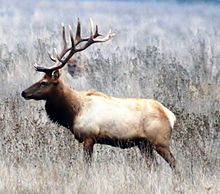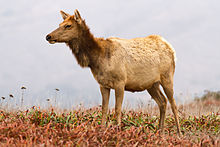Tule elk
| Tule elk | |
|---|---|
 |
|
| Tule elk bull at Merced National Wildlife Refuge, courtesy of Bill Leikam | |
 |
|
| Tule elk cow at Tomales Point, Point Reyes National Seashore | |
| Scientific classification | |
| Kingdom: | Animalia |
| Phylum: | Chordata |
| Class: | Mammalia |
| Order: | Artiodactyla |
| Family: | Cervidae |
| Subfamily: | Cervinae |
| Genus: | Cervus |
| Species: | C. canadensis |
| Subspecies: | C. c. nannodes |
| Trinomial name | |
|
Cervus canadensis nannodes |
|
The tule elk (Cervus canadensis nannodes) is a subspecies of elk found only in California, ranging from the grasslands and marshlands of the Central Valley to the grassy hills on the coast. The subspecies name derives from the tule, a species of sedge native to freshwater marshes on which the Tule elk feeds. When the Europeans first arrived, an estimated 500,000 tule elk roamed these regions, but by 1870 they were thought to be extirpated. However, in 1874-1875 a single breeding pair was discovered in the tule marshes of Buena Vista Lake in the southern San Joaquin Valley. Conservation measures were taken to protect the species in the 1970s. Today, the wild population exceeds 4,000. Tule elk can reliably be found in Carrizo Plain National Monument, Point Reyes National Seashore, portions of the Owens Valley from Lone Pine to Bishop, and on Coyote Ridge in Santa Clara Valley, San Jose, California.
Considered the smallest of the wapiti in North America, the tule elk were the dominant large ungulate in California prior to the arrival of the Spanish. It is typically described as the smallest subspecies of all American elks, with the average weight of adult males only 450 to 550 lb (200 to 250 kg) and females average of 375 to 425 lb (170 to 193 kg). Although tule elk have been reported as half the size of the Roosevelt elk, and sometimes referred to as the dwarf elk, this moniker may be misleading as the smaller size of some tule elk may reflect poor nutrition of elk subsisting on marginal habitat such as the Owens River watershed. California Department of Fish and Wildlife records show recent bull elk on Grizzly Island in Suisun Bay weigh up to 900 pounds (410 kg). This is a similar size to Roosevelt elk bulls which weigh between 700 pounds (320 kg) and 1,100 pounds (500 kg). Wildlife biologist Dale McCullough described an elk transplanted from Buttonwillow in the San Joaquin Valley to a golf course in Monterey that grew to the size of a Rocky Mountain elk. Also hunter H. C. Banta described the tule elk in the 1850s as "I found no difference in size between these elk and the Oregon, Washington, Wyoming and Colorado elk, and felt sure that the bulls would weight 700 to 800 pounds".
...
Wikipedia
